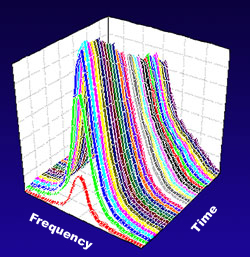Nov. 24, 2004

[NIST
Tech Beat Search] [Credits] [NIST Tech Beat
Archives] [Media
Contacts] [Subscription Information]

Four
Organizations Receive Presidential Quality Award

|
Bama
employees working hand-held pie line.
|
President
George W. Bush and Commerce Secretary Don Evans announced on
Nov. 23, 2004, that four organizations have been selected to
receive the 2004 Malcolm Baldrige National Quality Award, the
nation’s only Presidential award for quality and organizational
performance excellence.
The 2004
Baldrige Award recipients are: The Bama Companies, Tulsa, Okla.
(manufacturing category); Texas Nameplate Company, Inc., Dallas,
Texas (small business category); Kenneth W. Monfort College
of Business, Greeley, Colo. (education category); and Robert
Wood Johnson University Hospital Hamilton, Hamilton, N.J. (health
care category). This is the second time that Texas Nameplate
has been named a recipient of the Baldrige Award; the first
time was in 1998. Baldrige Award recipients can reapply for
the award after five years.
Improvement
highlights from these four organizations include:
-
While
the overall frozen baked goods industry has remained relatively
flat since 1999, Bama’s sales have increased 47 percent
and its profit margins have improved 19 percent.
-
Texas
Nameplate has cross-trained more than 80 percent of its 39
employees to perform multiple jobs across departments.
-
Student
performance at Monfort College of Business consistently has
been well above the national mean and in 2003-2004 reached
the top 10 percent level.
-
In
1998, Robert Wood Johnson University Hospital implemented
the “15/30” program which guarantees that patients
coming into the emergency department will see a nurse within
15 minutes and a physician within 30 minutes.
Named after
the 26th Secretary of Commerce, the Malcolm Baldrige National
Quality Award was established by Congress in 1987 to promote
excellence in organizational performance, recognize the quality
and performance achievements of U.S. organizations, and publicize
successful performance strategies. The Award is managed by NIST
in conjunction with the private-sector. For more information
on the 2004 Baldrige Award recipients, see www.nist.gov/public_affairs/releases/2004baldrigewinners.htm.
Media
Contact:
Jan
Kosko, janice.kosko@nist.gov,
(301) 975-2767


Ultrafast
Laser Speeds Up Quest for Atomic Control

|
Just
as a satellite requires a boost of power to change from
one Earth orbit to a higher one, electrons require an
energy boost (in quantum steps) to change from one orbital
pattern around the nucleus to another. JILA researchers
used pulses of ultrafast laser light to boost the outer
electron in rubidium atoms to higher, "excited"
levels, then detected the energy released by the atoms
in the form of fluorescent light as they "relaxed"
back to their natural state. This three-dimensional
plot shows changes in the intensity of the light emitted
by the atoms in 300 microseconds. The JILA technique
should allow scientists to measure and control these
"transitions" between atomic energy levels
much more efficiently than with conventional methods.
|
It's
the scientific equivalent of having
your cake and eating it too. A team of researchers from JILA,
a joint institute of the Commerce Department's National Institute
of Standards and Technology (NIST) and the University of Colorado
at Boulder, has developed an efficient, low-cost way to measure
the energy levels of atoms in a gas with extremely high accuracy,
and simultaneously detect and control transitions between
the levels as fast as they occur. The technique is expected
to have practical applications in many fields, including astrophysics,
quantum computing, chemical analysis, and chemical synthesis.
Described
in the Nov. 18 online issue of Science Express,*
the method uses ultrafast pulses of laser light like a high-speed
movie camera to record in real-time the energy required to
boost an atom's outer electrons from one orbital pattern to
another. The pulses are so short that scientists can track
precisely the fraction of atoms in each energy state and how
those populations change with time. Moreover, the atoms respond
to subsequent laser pulses cumulatively—the energy adds
up over time—which allows fine-tuning to affect specific
orbital patterns of interest with a much lower power laser
than usual.
All
of chemistry depends on the configurations of these outer
electrons. The technique promises to make it easier for scientists
to systematically understand the radiation "signatures"
(or spectra) given off by atoms and molecules as their electrons
jump between different energy levels. Ultimately, it should
allow improved control of the complex chain of events that
combines atoms into desired compounds.
The
JILA team is a world leader in applying so-called "frequency
combs" to practical science problems. The laser system
used in the current work emits a hundred thousand different
infrared frequencies at once in individual pulses lasting
just femtoseconds (quadrillionths of a second). The JILA researchers
used the laser to precisely study the electron energy levels
within an ultracold gas of rubidium atoms. The ability to
probe atoms with many different laser frequencies simultaneously
and to monitor atom responses in real time should allow scientists
to study and control systems in a vastly more efficient and
precise manner.
*A. Marian,
M. C. Stowe, J.R. Lawall, D. Felinto, and J. Ye. 2004. "United
time-frequency spectroscopy for dynamics and global structure."
Science Express.
Media
Contact:
Laura
Ost, laura.ost@nist.gov,
(301) 975-4034


Planning
for Extreme Events by Understanding Risk
Terrorist
attacks like those on Sept. 11, large-scale industrial accidents
like Three Mile Island, hurricanes like Andrew, or earthquakes
like the one in Northridge, Calif., that killed 60 people—these
are all what economists call low probability, high consequence
events. Making economic decisions about how to prepare for
such "extreme events" is a difficult process. Under
what circumstances are the benefits of strengthening a building
against explosions or earthquakes worth the costs? A new study
sponsored by the National Institute of Standards and Technology
(NIST) offers strategies for finding answers to such questions.
Conducted
by the University of Pennsylvania's Wharton School, the study*
found that preparing for extreme events requires an understanding
of risk "interdependencies." A security plan, for
example, is only as strong as its weakest link. It also requires
cooperation between public and private organizations because
individuals and organizations often don't take actions to
mitigate low probability risks unless there are incentives
to do so.
Ultimately,
the study authors concluded that dealing effectively with
extreme events depends on a complex interplay between risk
assessment, perception and management. Risk assessment for
a power grid in Ohio needs to include possible negative effects
from domino-like failures throughout the northeastern United
States and Canada. People perceive risk more clearly when
they understand its cumulative effects. More people will wear
seatbelts, for instance, if told they have a 33 percent chance
of an accident over a 50-year lifetime of driving than if
they know there is 0.00001 percent chance for each trip. And
risk management is more likely if the economics are attractive.
A $1,500 loan to prevent flood damage is more affordable if
payments are divided over the life of a 20-year mortgage and
if insurance premiums drop as a result of the improvements.
*An electronic
copy of Risk Analysis for Extreme Events: Economic Incentives
for Reducing Future Losses by Howard Kunreuther, Robert
Meyer and Christophe Van den Bulte is available at
www.bfrl.nist.gov/oae/oae.html.

New
Project Takes Measure of Plastic Electronics
In
the future, the phrase smarty pants might be taken quite literally,
referring to trousers embedded with electronic “intelligence”
so that they change color, for example, in response to their
surroundings.
The timing
of this vernacular twist will depend on when plastic “chips”
become practical—so
cheap and reliable that electronic circuits can be printed not
only on clothing but also on paper, billboards and nearly anything
else. Unlike today's largely silicon-based technologies, organic
(carbon-based) materials are flexible, can be processed at low
temperatures and lend themselves to large-area applications,
such as wall-sized electronic murals.
Before
the emerging field of organic electronics can deliver on its
commercial promise, however, new measurements, standards and
processing capabilities must be developed. Creating many of
the requisite tools is the aim of a new five-year research effort
at the National Institute of Standards and Technology (NIST).
“Organic
electronics is at a stage akin to the very early days of the
silicon semiconductor industry,” explains NIST polymer
scientist Eric Lin. “Lack of validated diagnostic probes
and standardized test and measurement methods is an impediment
to progress.”
Unfortunately,
the job of filling this void is especially challenging. The
range of potential materials for organic electronics—from
polymers to nanocomposites—is enormous. The number of
synthesis and processing methods under consideration is also
daunting. Examples include ink-jet printing, roll-to-roll printing
and various ways to coax molecules to self-assemble into components.
Accurate,
reliable measurements will help solve current manufacturing
issues and speed widespread use of the new microchips. Ultimately,
says Lin, NIST plans to develop an “integrated measurement
platform.” The envisioned tool will allow scientists and
engineers to predict the performance of organic electronic devices
based on composition, structure and materials properties.
Media
Contact:
Mark
Bello, mark.bello@nist.gov,
(301) 975-3776
Quick
Links
NIST
Co-funded Technologies Tapped for Scientific American
50
Three
path-breaking industrial R&D projects co-sponsored
by the National Institute of Standards and Technology’s
Advanced Technology Program (ATP) are among the 50
technologies and companies cited by the journal Scientific
American for “outstanding technology leadership”
in business in 2003-2004.
The
three technology innovations include:
The
"Scientific American 50" appears
in the December issue of magazine and at www.sciam.com.
|

